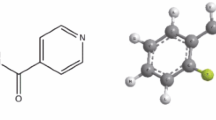Abstract
A highly sensitive analytical method has been developed for trace level quantification of formaldehyde in active pharmaceutical ingredient. Formaldehyde is a highly toxic impurity. Determination of formaldehyde by using UV-visible spectroscopy is difficult due to interference of unreacted derivatizing agent; hence, either HPLC-UV or GC-MS are used for the quantification. However, we have developed an indirect method for the quantification of formaldehyde. In this method, in the first step, formaldehyde reacted with excess of 2,4-dinitrophenyl hydrazine (2,4-DNPH). In the second step, the quantification of unreacted 2,4-DNPH was done by detecting its derivative with its scavenger—cinnamaldehyde on a UV-visible spectrophotometer. The developed method is rapid, simple, sensitive and accurate for the quantification of formaldehyde. Linearity of the method was observed in the range of 0.5–3 μg/mL with determination coefficients (r2) > 0.999. The limit of detection and limit of quantification are 0.25 and 0.5 μg/mL, respectively.




Similar content being viewed by others
REFERENCES
Nageshwari, A., Krishna Reddy, K., and Mukkanti, K., Chromatographia, 2012, vol. 75, p. 275.
Formaldehyde, EPA (Environmental Protection Agency Regulation), 1992 (Updated January 2000). https:// www.epa.gov/sites/production/files/2016-09/documents/formaldehyde.pdf.
Schulte, H., Bernauer, U., Madle, S., Mielke, H., Herbst, U., Richter-Reichhelm, H., Appel, K., and Remmy. U., Assessment of Carcinogenicity of Formaldehyde, Berlin, 2006, p. 1.
Liteplo, R., Beauchamp, R., Meek, M., and Chenier, R., Formaldehyde, Geneva: World Health Organization (WHO), 2002.
Formaldehyde (HCHO) CAS no. 50-00-0. https://www.atsdr.cdc.gov/MHMI/mmg111.pdf.
Li, Z., Jacobus, L., Wuelfing, W., Golden, M., Martine, G., and Reed, R., J. Chromatogr. A, 2006, vol. 1104, p. 1.
Raman, N. and Prasad, A., Org. Process Res. Dev., 2014, vol. 18, no. 7, p. 834.
Impurity in New Drug Substances, ICH Harmonized tripartite guideline, Q3A(R2), Current step 4 version, ICH, 2006.
Siegel, D., Meinema, A., Permentier, H., Hopfgartner, G., and Bischoff, R., Anal. Chem., 2014, vol. 86, p. 5089.
Bhalerao, V., Endres, J., and Kummerow, F., J. Am. Oil Chem. Soc., 1961, vol. 38, p. 689.
Tummalapalli, M. and Gupta, B., J. Carbohydr. Chem., 2015, vol. 34, p. 338.
Hladova, M., Martinka, J., Rantuch, P., and Necas, A., Res. Pap.—Fac. Mater. Sci. Technol., Slovak Univ. Technol., 2019, vol. 27, no. 44, p. 105.
Gholami, A., Mohsenikia, A., and Masoum, S., J. Anal. Methods Chem., 2016, vol. 2016, p. 1720530.
Saczk, A., Okumura, L., Oliveira, M., Zanoni, N., and Stradiotto, R., Anal. Bioanal. Chem., 2005, vol. 381, p. 1619.
Gangrade, D., Nema, R., and Singhvi, I., Int. J. Chem. Pharm. Anal., 2014, vol. 2, no. 1, p. 2.
Roloff, A., Budau, N., Ruhle, B., Borcherding, H., Thiele, T., Schedler, U., and Genger. U., Anal. Chem., 2019, vol. 91, p. 8827.
Ressmann, A., Schwendenwein, D., Leonhartsberger, S., Mihovilovic, M., Bornscheuer, U., Winkler, M., and Rudroff, F., Adv. Synth. Catal., 2019, vol. 361, p. 2538.
Hudson, E., Ariya, P., and Gelinas, Y., Environ. Chem., 2011, vol. 8, p. 441.
Jeong, H., Chung, H., Song, S., Kim, C., Lee, J., and Kim, Y., Toxicol. Res., 2015, vol. 31, p. 273.
Kumar, S. and Shrivastava, R., Ind. J. Pharm. Sci., 2018, vol. 80, no. 4, p. 744.
Veloso, M., Silva, V., Santos, G., and Andrade, J., J. Chromatogr. Sci., 2001, vol. 39, p. 173.
O’Brien, P., Siraki, A., and Shangari, N., Crit. Rev. Toxicol., 2005, vol. 35, p. 609.
Phadke, R., Gosar, A., Patil, D., Gupta, K., and Mali, R., World J. Pharm. Pharm. Sci., 2019, vol. 8, no. 12, p. 1010.
Dator, R., Solivio, M., Villalta, P., and Balbo, S., Toxics, 2019, vol. 7, no. 32, p. 1.
M7(R1) Assessment and Control of DNA Reactive (Mutagenic) Impurities in Pharmaceutical to Limit Potential Carcinogenic Risk, Guidance for Industry, ICH, 2018.
Validation of Analytical Procedures Texts and Methodology Q2(R1), ICH Harmonised tripartite guideline, 2005, Current step 4 version.
Ghosh, S., Kumar, M., Jena, S., Banji, D., and Roy, S., Asian J. Res. Chem., 2012, vol. 5, no. 12, p. 1472.
Author information
Authors and Affiliations
Corresponding authors
Ethics declarations
The authors declare that they have no conflicts of interest.
Rights and permissions
About this article
Cite this article
Vidyagauri V. Lele, Uttam Prabhanand Dalvi Application of Induced Bathochromic Shift for Trace Level Quantification of Formaldehyde in Some Antiviral and Anti-Microbial Drugs with Cinnamaldehyde as 2,4-Dinitrophenyl Hydrazine Scavenger Using UV-Visible Spectroscopy. J Anal Chem 78, 681–686 (2023). https://doi.org/10.1134/S1061934823060072
Received:
Revised:
Accepted:
Published:
Issue Date:
DOI: https://doi.org/10.1134/S1061934823060072




